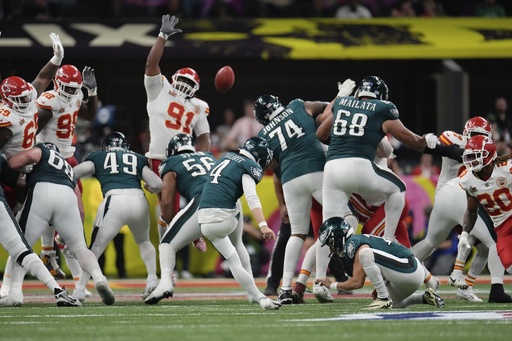
NEW ORLEANS — In a remarkable display of talent and strategy, the Philadelphia Eagles, led by Nick Sirianni and Jalen Hurts, claimed their second Super Bowl title by defeating the Kansas City Chiefs 40-22 in Super Bowl 59. This victory marked a historic moment, with the Eagles joining an elite group of teams that have won multiple Super Bowls with different head coaches and quarterbacks.
Winning consecutive championships in the NFL is not unheard of, especially when featuring dominant coach-quarterback duos. However, achieving this with different personnel in those key roles is quite rare. Only two other franchises in NFL history have accomplished this feat within an eight-year span. The first instance came from the Oakland Raiders, who secured their inaugural championship during the 1976 season under coach John Madden and quarterback Ken Stabler, followed by another victory in 1980 with Tom Flores and Jim Plunkett at the helm. Similarly, the San Francisco 49ers enjoyed success beyond the tenure of Bill Walsh, with George Seifert capturing titles in 1989 and 1994, both with different quarterbacks from Walsh’s era.
The difference in roster continuity between these franchises is noteworthy. The Raiders boasted 11 players who appeared in both Super Bowl victories, while the 49ers had six, including Hall of Famer Jerry Rice. In contrast, the Eagles experienced significant roster turnover, with only four players — Lane Johnson, Brandon Graham, Jake Elliott, and long snapper Jake Lovato — representing the team in both Super Bowl wins. The single constant for Philadelphia has been general manager Howie Roseman, who has been instrumental in constructing two championship-caliber teams.
The game was also significant for college football, marking firsts for the football programs of Alabama and Texas. Notably, DeVonta Smith, the Eagles’ wide receiver, scored the first Super Bowl points by an Alabama alumnus, with his 46-yard touchdown catch. Prior to this, players from 144 other colleges had found the end zone in the Super Bowl. Following this victory, Smith joined an exclusive group of individuals who have won both the Heisman Trophy and Super Bowl championships, a club consisting of just four other players, including Tony Dorsett and Reggie Bush.
The Longhorns, represented by Xavier Worthy, also made history when he caught two touchdown passes for Kansas City, marking the first touchdowns from a Texas alumnus in Super Bowl history. Additionally, Justin Watson made a notable impact by scoring the first points from a player representing Penn, illustrating how these historically significant college programs are now finding their place in Super Bowl lore.
Within the game, Jalen Hurts tied Patrick Mahomes in Super Bowl matchups, marking this as the fourth rematch between quarterbacks. Previously, Mahomes secured the victory over Hurts in Super Bowl 57, making Hurts the only quarterback to exact revenge in a rematch format among others who had lost their initial Super Bowl appearances. Furthermore, he became one of only four quarterbacks in history to win a Super Bowl after losing their first.
Despite the hype surrounding running backs, it was the quarterbacks who led their respective teams in rushing yards. Hurts broke his own Super Bowl record by rushing for 72 yards, while Mahomes contributed 25 yards, marking an unprecedented situation where the leading rushers for both squads were their quarterbacks. In contrast, Kansas City’s traditional running backs managed only 24 rushing yards combined, highlighting a stark decrease in ground game production.
Even notable players like Saquon Barkley struggled, accumulating just 57 yards on 25 carries, resulting in an average of 2.28 yards per run. However, Barkley’s impressive overall season should not be overlooked, as he amassed a total of 2,504 rushing yards, surpassing the previous postseason record of 2,476 yards set by Terrell Davis in 1998.
With this victory, the Eagles reinforced the NFC East’s status as the only division where every team has obtained at least two Super Bowl titles. Overall, the division has collectively won 14 Super Bowls, surpassing any other division in the league. Following the NFC East, the AFC West ranks second with a total of 10 Super Bowls, while the AFC East has nine to its name. The NFC West and AFC North each claim eight titles, and the NFC North has produced five champions, with the NFC South and AFC South rounding out the list with three and two titles, respectively.

